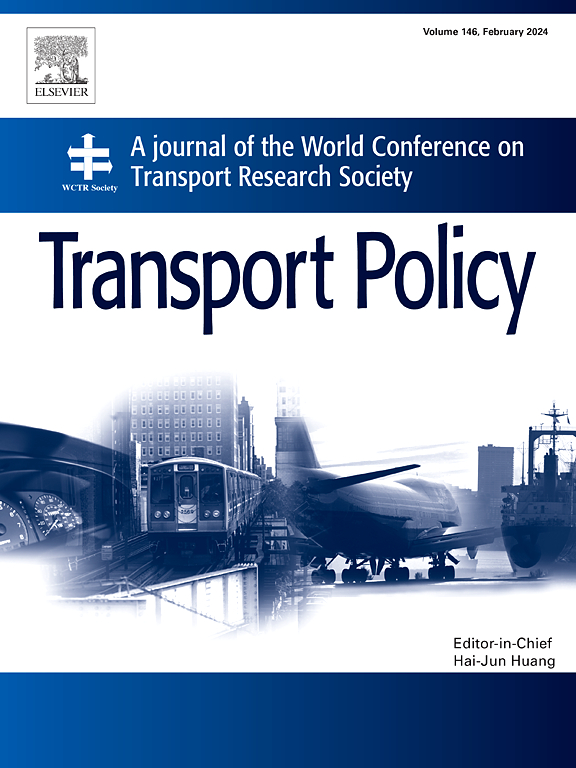内河航道深度随季节变化的最优船队规模
IF 6.3
2区 工程技术
Q1 ECONOMICS
引用次数: 0
摘要
内河走廊为内陆城市和出口海港之间提供了重要的联系。与海上航道不同,在丰水期和干旱期,内河廊道的通航船舶大小受航道深度的制约。本文采用垂直结构模型,研究了水道深度随季节变化的内河廊道船队规模设计问题。在提出的模型中,考虑了货主、竞争承运人和公共港口运营商在丰水期和干旱期之间的相互作用,以及季节性水道深度对船队规模的影响。托运人在每个周期内选择转运港口的目的是将运输成本降到最低。竞争承运人的目的是通过确定每个时期的运费率和给定时间范围内的船队规模(船舶频率和船舶规模的组成)来最大化自己的净利润。公共港口经营者作为政府的代理人,决定每个时期的港口服务收费,以在给定的时间范围内实现社会福利最大化。研究了旱期持续时间与丰期持续时间之比(duration ratio)、小船型与大船型之比(ship size ratio)、大船型在旱期的实际载货量对利益相关者和系统的影响。研究结果表明:(1)在丰收期,政府总是倾向于对各港口的承运商进行持续时间较大的补贴,而在干旱期,政府则倾向于对竞争港口的承运商进行持续时间较小、各港口大型船舶载货量较低的补贴;(ii)单一的大(或小)船型策略将低估(或高估)干旱时期大型船舶低载货量的船队规模。本文提出的方法可以为承运人的船队规模计划和政府的港口监管提供有用的工具,从而实现货主、承运人和港口经营者的“三赢”结果。本文章由计算机程序翻译,如有差异,请以英文原文为准。
Optimal ship fleet size in an inland river corridor with seasonal change in waterway depth
Inland river corridor provides a significant connection between inland cities and export seaports. Different from the sea waterway, the navigable ship size in an inland river corridor is restricted by the waterway depths in the plentiful and drought periods. This paper deals with the design issue of ship fleet size in an inland river corridor with seasonal change in waterway depth using a vertical structure model. The interactions among consignors, competitive carriers and a public port operator over plentiful and drought periods are considered in the proposed model, together with the impacts of seasonal waterway depth on the ship fleet size. The consignors aim to minimize transport cost by choosing transfer ports in each period. The competitive carriers are intended to maximize their own net profit by determining the shipping freight rates in each period and the ship fleet size (ship frequencies and composition of ship size) over a given time horizon. A public port operator, as an agent of the government, decides the port service charges in each period to maximize social welfare over the given time horizon. The effects of the ratio of drought period duration to plentiful period duration (duration ratio), the ratio of small ship size to big ship size (ship size ratio), and the actual cargo load of big ship in the drought period on the stakeholders and the system are investigated. The results show that: (i) the government always tends to subsidize the carrier at each port in the plentiful period for a large duration ratio, but to subsidize the carrier at its competitive port in the drought period for a small duration ratio and a low cargo load of a big ship at each port; and (ii) a single big (or small) ship type strategy will underestimate (or overestimate) the ship fleet size for a low cargo load of a big ship in the drought period. The method proposed in this paper can serve as a useful tool for the fleet size plan for the carriers and for port regulation for the government so as to achieve a “win-win-win” outcome among consignors, carriers and port operator.
求助全文
通过发布文献求助,成功后即可免费获取论文全文。
去求助
来源期刊

Transport Policy
Multiple-
CiteScore
12.10
自引率
10.30%
发文量
282
期刊介绍:
Transport Policy is an international journal aimed at bridging the gap between theory and practice in transport. Its subject areas reflect the concerns of policymakers in government, industry, voluntary organisations and the public at large, providing independent, original and rigorous analysis to understand how policy decisions have been taken, monitor their effects, and suggest how they may be improved. The journal treats the transport sector comprehensively, and in the context of other sectors including energy, housing, industry and planning. All modes are covered: land, sea and air; road and rail; public and private; motorised and non-motorised; passenger and freight.
 求助内容:
求助内容: 应助结果提醒方式:
应助结果提醒方式:


